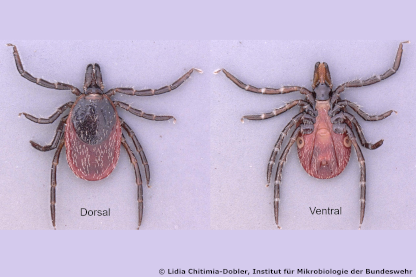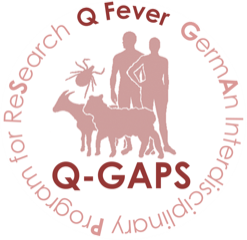Modelling uptake and organ distribution of the Q fever agent Coxiella burnetii by ticks and possible effects on virulence.

[Photo: Lidia Chitimia-Dobler, Bundeswehr Institute of Microbiolog
Dorsal und ventral view of a female tick of the species Ixodes ricinus
Abstract
In subproject 3, the role of ticks as vectors for transmitting Q fever will be investigated. The aim of these studies is to clarify the role of the sylvatic cycle (postulated by literature) for the epidemiology of Q fever. To determine vector competence of ticks, an artificial tick feeding model will be developed and tested by means of Coxiella isolates of different origin. Furthermore, the subproject deals with isolate-specific differences in pathogeny and virulence. To confirm any observed isolate-specific virulence potential in these models, confirmatory tests on the proteome level will be performed and the data from genome analysis will be correlated. In addition, bacterial markers are intended to be identified which will contribute to the differentiation of circulating isolates and could enable the detection of especially virulent isolates. Both approaches will support the implementation of suitable counter measures.
Principal investigators

Dr. Katja Mertens-Scholz
Friedrich-Loeffler-Institut
Institut for Bacterial Infections
and Zoonoses
Web link
Head of National Reference Laboratory for Q fever
Web link
Naumburger Str. 96a
07743 Jena
Katja.Mertens-Scholz(at)fli.de

Dr. med. vet. Klaus Henning
Friedrich-Loeffler-Institut
Institut for Bacterial Infections
and Zoonoses
Naumburger Str. 96a
07743 Jena
Scientific Assistants
Friedrich-Loeffler-Institut
Institute for Bacterial Infections
and Zoonoses
Naumburger Str. 96a
07743 Jena
Friedrich-Loeffler-Institut
Institute for Bacterial Infections and Zoonoses
Naumburger Str. 96a
07743 Jena


